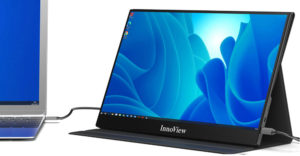
The fear of failure factor is one reason why potential newcomers to the Linux operating system never complete the switch. After all, when was the last time you saw a sign in a big-box computer store identifying the aisle labeled “Linux Loaded?”
Most desktops and laptops come out of the box with Microsoft Windows pre-installed. Don’t even think about asking about Linux in an Apple goodies store. Linux options in most storefronts are limited at best.
Buying Linux-loaded computers online can be a safe but often pricey option. A better strategy is buying a Windows PC off the shelf and installing a Linux distro in a separate partition on the hard drive yourself. The Linux installer will automatically create a dual boot GRUB 2 startup screen. Since the Linux OS is free, why not have both available even if you never need to boot into Windows?
If you do not buy smart, however, you could spend hours troubleshooting, trying to figure out why Linux won’t boot or why some key component won’t work. That leaves you with several daunting options, such as a trip to return the computer or spending a ton of money for a store computer tech — if you can find one who actually knows Linux — to force a possible fix.
Even if you know Linux, buying a desktop or laptop computer and installing a Linux distro on it may be glitch-free or trouble-ridden. You have no guarantees that what you buy will run what you want. It depends on the internal components and whether your distro of choice will fully support the underlying hardware ands peripheral devices.
I often service friends, associates and clients who want to migrate to Linux. So I spend considerable time installing various distros on legacy equipment as well as on new gear. I recently gave in to buying a new laptop to replace a favorite but aging model. Along the way I gained some valuable insights into making Linux work on computers old and new.
Hardware Factor
When it comes to hardware power from processors, chipsets and system memory, Linux OSes have a much lower threshold than Microsoft’s Windows 7 and Windows 8 and Apples’s Mac OS X. So system resources are less of an issue than system compatibility. That means you can run the latest Linux OS without having to buy a more expensive new computer.
The trick is doing your homework before you walk into the store or click the buy button online. If you know the tripping points, you can step around them and eliminate any chance of hardware disconnect that prevents Linux from working.
More so than hardware incompatibility, system memory is usually not a critical factor. For example, Linux distros have a minimum RAM (random access memory) requirement of 128MB to at least run. But Linux works much better with at least 192MB.
The type of RAM isn’t usually important — the performance differences in RDRAM, SDRAM and DDR are barely noticeable.
No WiFi?
Once Linux is installed, the first thing you should verify is hardware compatibility. Often, the problem with Linux not running on a particular computer is caused not by the hardware itself. The culprit is the lack of an open source driver, or at least a proprietary driver provided by the device’s manufacturer and made available to the distro’s developer.
A good example of this phenomenon is a recent buying experience I suffered. I bought a well-endowed laptop from a well-known manufacturer’s website. It ran Windows 7 very well. I partitioned the hard drive and installed Linux Mint 13.
The wireless network card remained unrecognizable to the Linux OS. It did not matter that the wireless connection worked in Windows 7. The cabled Internet connection worked equally fine in Linux, though.
Adding insult to injury, Puppy Linux, which boots from a USB flash drive and runs in system RAM, also refused to make a wireless connection. But again, the hard-wired connection to my router connected without incident.
Swapping Success
Armed with a live session DVD of Linux Mint 13, I visited a local big-box electronics store and spied the same model with a nearly identical hardware configuration. The laptop instantly grabbed the store’s WiFi connection. That success cinched my purchase.
Why did the store’s nearly identical laptop make the connection while the other unit refused? Comparing the list of system components offered the solution. The failed unit had a Broadcom wireless network card installed. The store’s product had an Intel network card.
The Broadcom device requires a proprietary driver that the computer maker did not license to provide. Broadcom does not distribute open source drivers, and no substitute drivers are compatible with Broadcom network cards.
Linux Inside
So never assume that hardware components within the same model lineage will be identical. It only takes a slight difference to adversely affect a Linux configuration.
Unless you buy Linux-certified computers from a specialty vendor, you have to do some homework or take leave it up to luck when you buy online or off the shelf. That is the only way to avoid driver incompatibility issues with other hardware components when installing a Linux OS distribution on a computer that is not tested or certified for Linux.
Avoiding these situations can result in a successful installation. Keep these points in mind to make Linux work on a new or old computer.
Driver Me Crazy
Processor choice is generally not a problem. I have a collection of gear that runs various family lines of Intel and AMD chips and have never had a processor-related problem. That goes for Windows PCs that I converted to Linux boxes. You have no worries about needing special Linux kernels for the processor to run the OS. From a buying perspective, AMD is less costly.
Graphic card choice can present some issues, so this is an area that needs checking. The two most common graphic card makers are Nvidia and ATI. I have computers that use both. I have not seen any major issues. But I noticed an occasional glitch or two with ATI devices. I assume the fault lies with the ATI drivers.
For example, sometimes desktop effects are missing or just do not work properly. When that happens, I chalk it up to ATI gremlins. The same settings running the same distro on my computers that are Nvidia based do not replicate the issue.
Hear Me Now?
Sound Cards can be tricky as they are often integrated onto the motherboard. This makes changing them impossible. Check the manufacturer’s website to see if Linux drivers are included for whatever sound components are installed.
A leader in Linux sound devices is the ALSA Project. I prevented trouble by checking the Sound Card Matrix before buying.
Linux settings include setup options for sound systems. Bring one or more live session disks to the computer store. Check out the sound performance as well as confirm that WiFi connects. I have seen situations where sound works on a music playback but not with a streaming video.
Driver Demise
Printer and scanner issues by far outnumber other compatibility concerns. Some big-name manufacturers are notorious for not providing Linux drivers for some or all of their products.
For example, Dell (Lexmark) All-In-One models are not Linux compatible. Many of Epson’s and HP’s printers, on the other hand, are supported for Linux use.
If you have a printer or scanner that your Linux distro cannot handle, look for a solution on that community’s online forums. Also check for work-around solutions on the device maker’s website. Often, you can find substitute drivers from other printers that will get the device working in Linux.
Nothing is more disheartening than not getting full use out of a Linux installation because you can’t print or scan without buying compatible devices. Before you commit to a particular distro or a specific printer or scanner, make sure one is compatible with the other.
Help Lines
A good source for printer compatibility information is Openprinting.org. This is a database of printers that work in Linux. So use it to find what works and what does not work.
A similar database for scanner compatibility is the SANE project. Another good source for Linux printer and scanner drivers is available at Linuxdrivers.org.
You will not always have a match for available printer drivers from CUPS (The Common Unix Printing System). Some Linux distros build in a printer setup link to CUPS. If yours does not, go there yourself by pointing your browser here.
Also check out the list of supported printers in this database maintained by Linuxprinting.org.






















































TFA is far too negative. I have spent the last 12 years installing GNU/Linux on random PCs in schools. I only met one that would not boot and that was network-booting on an ancient PC. Occasionally some device will not work but that is rare and it’s not usually something that prevents booting so install GNU/Linux without fear. There’s always a way to get full use of a PC. Even a partially successful installation of GNU/Linux will be superior to the malware and re-re-reboots of that other OS.
Further, there is no need to ever go into a store and buy a PC with that other OS to install GNU/Linux. Many reputable on-line retailers will ship you a GNU/Linux PC or one with FreeDOS or No OS so more of your money goes into better hardware than M$’s pockets. Checkout http://www.walmart.com.br to see PCs sold by Walmart with GNU/Linux installed. If they can do that in Brazil, they can do it anywhere because hardware is no problem. The reason Walmart sells few PCs with GNU/Linux in USA/Canada has nothing to do with hardware compatibility or ease of use.
In case above method doesn’t work and if you have the windows drivers for your broadcom wifi card, you can also extract the firmware from the driver binary itself using an open source utility called "bcm43xx-fwcutter".
As mentioned above, Linux already has the drivers. You just need to install the right firmware !!
Sure they work…as long as security like WPA 2 isn’t something you actually care about. Me I’d prefer not to make my WiFi open for anyone and everyone to leech off of, thanks.
This article just shows what I’ve been saying for years which is Linux is NOT like Windows, its like Macs. Its no different than how you can build a Hackentosh IF you get the right parts and IF all the drivers work and IF you don’t pick anything later that isn’t well supported.
That is why if you want to run Linux? Buy from an actual Linux vendor like System76. Not only will you be assured the hardware is well supported but you’ll be showing that Linux actually has an audience, unlike when you buy a Windows OEM that counts on the metrics as a Windows sale.
Actually, most common Broadcom wi-fi cards (the b4300 series) will work in Linux. You just need to install the firmware from the Internet while connected via the wired connection. Ubuntu and derivatives even automate the process.
It’s misleading to say that there are "no substitute drivers" compatible with Broadcom network cards.